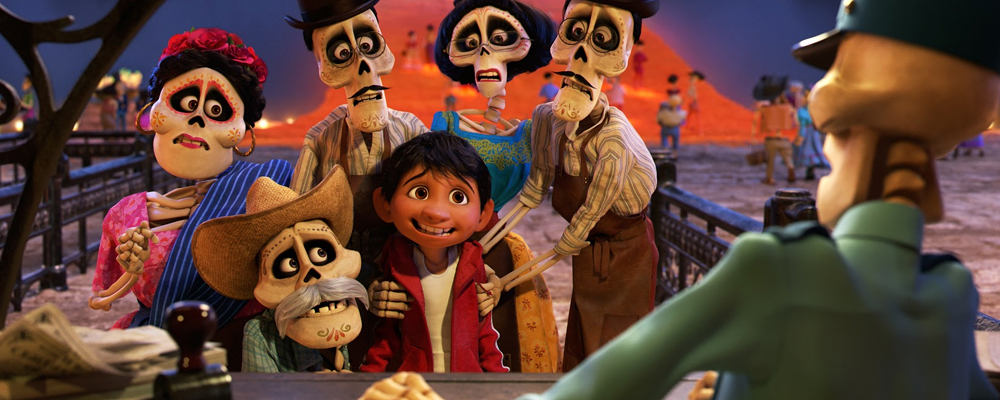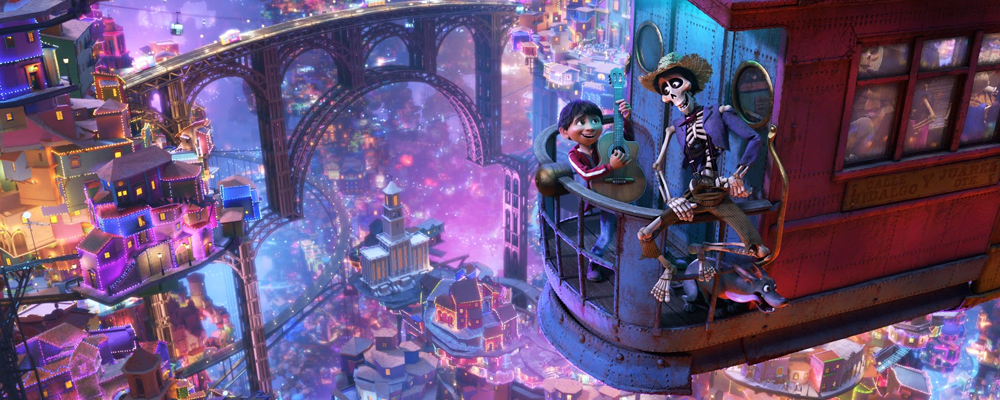‘Coco’ Celebrates Día de los Muertos With Visual Delights and Touching Laughs
Alci Rengifo
“Coco“ is that kind of family film that manages to tackle a tricky subject with heart and sensibility. Disney and Pixar have scored yet another wonderful visual achievement here, but this one is particularly notable for the way it uses Latin American culture to explore themes of death and remembrance. Visually “Coco” is an enrapturing movie. The iconography of Mexico’s Dia de Los Muertos (Day of the Dead) is used with elegance and fun, capturing the tradition’s unique mixture of remembrance and celebration. The kind of romance associated with Latin folk culture is beautifully celebrated with dramatic energy. But this is a warm-hearted movie that probes deeper into the meaning of family and independence. It dives into Mexican culture with much gusto and joyous music, but its story has a universal power.
The story is set in the rural Mexican town of Santa Cecilia where we meet Miguel (Anthony Gonzalez), a young boy who dreams of being a musician as he gets into trouble with his faithful dog Dante. Miguel’s great idol is the town legend, Ernesto de la Cruz (Benjamin Bratt), who left town to become a famous artist who met his end under a crashing bell during a final performance. But Miguel’s cobbler family has banned music under the watchful eye of his stern Abuelita (Renee Victor). The animosity stems from the family history revolving around Miguel’s great-great grandparents. His great-great grandfather also had dreams of making music and left his great-great grandmother behind in Santa Cecilia, never to return. The last, surviving link to this history is Miguel’s beloved great-grandmother, Mama Coco (Ana Ofelia Murguía), who sits in her chair serenely as the days go by. Miguel finds reasons to suspect he might be related to De La Cruz, and as the town prepares to celebrate El Dia de los Muertos, Miguel runs off and finds himself in the crypt containing the singer’s remains. Through a supernatural occurrence, Miguel finds himself transported to the Land of the Dead, a bustling city of souls seeking to revisit for just one night their living relatives who keep their memories alive through “ofrendas” (offerings). He immediately finds relatives, including his great-grandmother Mama Imelda (Alanna Ubach), who refuses to give him her blessing to be a musician. With the help of a mischievous skeleton named Hector (Gael Garcia Bernal), Miguel is determined to find De La Cruz and get his blessing to pursue his dreams.
“Coco” is both a fun time and a sumptuous celebration of culture. The Land of the Dead as imagined by directors Adrian Molina and Lee Unkrich is a brilliant, baroque vision of an afterlife set in a place that looks like a revival of 1950s Mexico City. Train stations, transit points and buildings look like underworld versions of the Mexico one sees in the golden age films of Pedro Infante, Silvia Pinal and Cantinflas. Everything is cast in a luminous beauty. The high tower where De La Cruz is hosting a massive Day of the Dead rave has the look and texture of an old Hollywood mansion, complete with a marvelous pool and ball room full of the ofrendas his fan base has sent from the beyond. There are great tributes to Mexico’s soap opera and classic film culture, and historical figures are treated with sly humor. For example Frida Kahlo (Natalia Cordova-Buckley) appears as a diva designing the stage on which De La Cruz will perform. She envisions a towering cactus through which copycats of herself will appear. It’s a witty, satirical take on the fact that Frida has gone the way of Che Guevara in becoming kitsch. De La Cruz himself is an homage to a suave tradition of Mexican singers such as Vicente Fernandez and Antonio Aguilar.
But the filmmakers have also used poetic ways to incorporate cultural details into the story. One of the finest is the bridge between the world of the dead and the living. It is a glowing set of pathways made-up of marigold flowers, which are part of the Day of the Dead celebrations. Even Miguel’s loyal dog Dante is a nice touch. He’s a Xolo dog, a breed that has been a pet since the days of the Aztec Empire. The town of Santa Cecilia is imagined with a sharp authenticity in its rural details reminiscent of areas such as Oaxaca. The cast itself features such prominent Mexican artists like Edward James Olmos as a sad, hammock-swaying skeleton named Chicharrón, and even veteran filmmaker Alfonso Arau voices Miguel’s grandfather Papa Julio. The iconic Day of the Dead imagery of skeletons and skulls is vividly imagined. Skeletons populate the Land of the Dead and everything is animated with a sense of folkloric artwork coming to life. Hector especially comes to life with humorous twists, bends and turns as a skeleton hoping to strike a deal: He will help Miguel find De La Cruz is Miguel will take his picture back to the world of the living, so he may be remembered and not forgotten..
“Coco” also has a universal power in its themes involving family. It celebrates the Latin American culture of big, united homes while exploring issues of abandonment and hurt with tact and tenderness. Mama Coco is a great creation, imagined with such warmth that anyone with a 97-year-old grandmother (including this reviewer) cannot help but smile at the image on screen. Little quirks common in Latino homes are instantly recognizable, like when Abuelita asks Miguel if he wants to eat more tamales and makes it clear she’s not really asking, but telling. This is also a unique Disney production in that its theme is essentially death and passing on. But it is never too dark or brooding, because the point of the Day of the Dead tradition is to mock death and celebrate the memory of loved ones. Death is treated here as a journey as opposed to a sad finale. Bernal recently described the film as “a beautiful reflection on death, and the celebration life,” and this is indeed an accurate description.
This being a Disney/Pixar production, one expects good music and we surely get it. The score by Michael Giacchino is lush and an orchestral amalgam using traditional Mexican melodies. “Coco” celebrates the diverse genres of Mexican music ranging from folk to country to that all famous romantic ballad. Scenes where Miguel performs in the Land of the Dead have a great energy. The songs by Kristen Anderson-Lopez and Robert Lopez are catchy escapism. Highlights include the cheerfully romantic “Un Poco Loco” and the designed to elicit tears number “Remember Me.”
“Coco” is a fun time for younger viewers and full of great artistry, pathos and music for anyone who walks into the theater. It’s a real delight. As Edward James Olmos recently commented on the meaning of the film, “That’s how we celebrate the Day of the Dead. We dress up, and you know, we go out, and we – ‘Trick or treat,’ you know. And think about that – versus what the Day of the Dead really represents for many of us, which is a time to celebrate in the memory of, and pass the stories on, and celebrate life at its fullest.”
“Coco” opens Nov. 22 nationwide.




